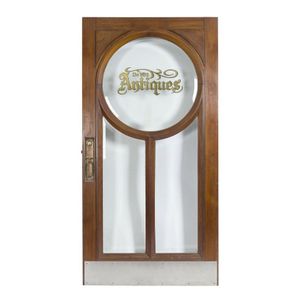Gilded Scagliola Pier Mirror, Swedish 1790
You must be a subscriber, and be logged in to view price and dealer details.
Subscribe Now to view actual auction price for this item
When you subscribe, you have the option of setting the currency in which to display prices to $Au, $US, $NZ or Stg.
- Scagliola - A process used in architecture, and manufacture of objects, where various colours of marble chips were embedded into a cement mix, which was usually white, in imitation of marble. Usually there was no pattern followed; the chips were embedded randomly unlike pietra dura which as well as incorporating semi precious stones, was usually laid out in a geometric or naturalistic pattern.
The process had been known since Roman times but was revived in Italy in the 17th century. Scagliola was incorporated into the interior design of some important English houses in the early 18th century and Italian crafsmen were brought over to install the material.
Scagliola was also used to make table tops, columns, pedestals and busts. - Circa - A Latin term meaning 'about', often used in the antique trade to give an approximate date for the piece, usually considered to be five years on either side of the circa year. Thus, circa 1900 means the piece was made about 1900, probably between 1895 and 1905. The expression is sometimes abbreviated to c.1900.
- Gilding - Gilding is a method of ornamentation whereby a thin sheet of gold metal is applied to items made of wood, leather, ceramics, glass and silver for decorative purposes.
For furniture including mirrors, the sheet of gold is usually applied over a coating of gesso. Gesso is a mixture of plaster of Paris and gypsum mixed with water and then applied to the carved wooden frames of mirrors and picture frames as a base for applying the gold leaf. After numerous coats of gesso have been applied, allowed to dry and then sanded a coat of "bole", a usually red coloured mixture of clay and glue is brushed on and allowed to dry, after which the gold leaf is applied. Over time parts of the gilding will rub off so the base colour can be seen. In water gilding, this was generally a blue colour, while in oil gilding, the under layer was often yellow. In Victorian times, gilders frequently used red as a pigment beneath the gold leaf.
Metal was often gilded by a process known as fire gilding. Gold mixed with mercury was applied and heated, causing the mercury to evaporate, the long-term effect of which was to kill or disable the craftsman or woman from mercury poisoning. The pursuit of beauty has claimed many victims, not the least of which were the artists who made those pieces so highly sought after today.
This item has been included into following indexes:
Visually similar items

Danish silver NEFROM brooch in flower form

Indonesian Kris with 13 waves and animal figure at base of blade

A pair of Chinese copper red dishes, Jiaqing mark and period (1796-1820), covered with a good even dark-red glaze interior and exterior, stopping neatly around the foot, fitted boxes, 14.7 cm diameter

De Witt Antiques shop door, Australian cedar and beveled glass with gilt lettering, 217 cm high, 108 cm wide
